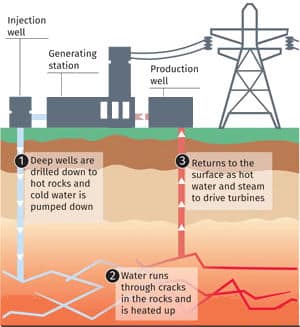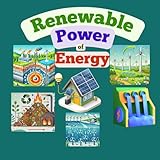
Geothermal Wells
Geothermal Wells for Heating and Cooling
![]() We know that geothermal energy is a clean, sustainable, and renewable energy source derived from the large amounts of energy stored as heat in the waters deep below the Earth’s surface. One of the primary means of harnessing this energy is through the use of Geothermal Wells, which are critical for accessing the Earth’s immense geothermal resources.
We know that geothermal energy is a clean, sustainable, and renewable energy source derived from the large amounts of energy stored as heat in the waters deep below the Earth’s surface. One of the primary means of harnessing this energy is through the use of Geothermal Wells, which are critical for accessing the Earth’s immense geothermal resources.
Geothermal Wells are drilled to access geothermal reservoirs, which are pockets of hot water and steam trapped beneath the Earth’s surface. These wells can be several kilometres deep, depending on the location and the geothermal gradient of the region. The geothermal gradient refers to the rate at which the Earth’s temperature increases with depth, and it varies significantly across different geographical areas.
Generally, geothermal power plants are environmentally clean, since they do not burn traditional fossil fuels. They can also be smaller in size compared to the more traditional types of power plants, reducing its visual impact on the surrounding landscape. As there is little need for large artificial lakes or cooling ponds. Also, once a well has been drilled and tapped, it effectively becomes completely invisible as the wellhead itself is buried underground.

Geothermal power plants are usually built right next to, or on top of, geothermal wells with the type and quality of the geothermal resource extracted depending on the type of fluid available, hot water, or dry steam, etc.
The fresh liquid water that geothermal wells produces used for electrical energy generation, heating or cooling, or other such direct purposes.
Types of Wells in Geothermal Energy
Natural geothermal features, such as geysers and hot springs can be found throughout the world, and geothermal wells can be broadly classified into three types based on their function and the method used to extract geothermal energy:
- Production Wells – Production wells are designed to extract hot water and steam from geothermal reservoirs. The extracted fluid is then used to generate electricity or for direct heating applications. These wells are typically lined with steel casings to prevent collapse and to protect groundwater from contamination.
- Injection Wells – Injection wells are used to re-inject the cooled water back into the geothermal reservoir after it has been used for energy production. This process helps to sustain the reservoir’s pressure and ensures the long-term viability of the geothermal resource. Injection wells are an integral part of the closed-loop system used in many geothermal power plants.
- Monitoring Wells – Monitoring wells are installed to observe the temperature, pressure, and chemical composition of the geothermal reservoir over time. Data from these wells are crucial for managing the geothermal field and for ensuring safe and sustainable operations.
Drilling geothermal wells is a complex and expensive process that generally requires advanced technology and expertise. The first step in drilling a geothermal well is selecting an appropriate site which may involve geological surveys, seismic studies, and other geophysical methods to identify potential geothermal reservoirs. Factors such as the geothermal gradient, the presence of hot springs, and the geological structure of the area are taken into consideration.
Once a suitable site is identified, drilling begins. Rotary drilling rigs equipped with diamond or tungsten carbide bits are commonly used. Drilling a geothermal well can take several weeks to months, depending on the depth and the geological conditions. During drilling, a liquid solution is circulated to cool the drill bit, and to carry cuttings to the surface stabilising the wellbore.
The final stage involves completing the well by installing production equipment such as production tubing and wellhead assemblies. The well is then tested to determine its capacity, productivity, and the characteristics of the geothermal fluid. Flow tests and pressure tests are conducted to assess the well’s performance.
Clearly, the construction of geothermal wells requires an initial investment in finding reservoirs, digging wells, and then building a geothermal power plant with turbines. But once built, it can be more economical than producing power by burning fossil fuels since these types of fuels do not have to be purchased or transported, reducing costs.
Applications in Heating and Cooling
Geothermal wells are not only used for electricity generation but can also play a significant role in direct heating and cooling applications. The most common systems for these applications are geothermal heat pumps and district heating systems.
Geothermal Heat Pumps (GHPs), also known as ground-source heat pumps, utilise the relatively constant temperature of the Earth’s subsurface to provide heating and cooling for buildings. GHPs consist of three main components: the ground heat exchanger, the heat pump unit, and the distribution system.
The ground heat exchanger is buried in the ground near the building. It consists of a network of pipes, commonly made of high-density polyethylene (HDPE), which circulate a fluid (water or a water-antifreeze mixture). In closed-loop systems, the fluid circulates through a continuous loop of pipes buried either horizontally or vertically. Horizontal loops are typically installed in trenches, while vertical loops are installed in boreholes.
In open-loop systems draw groundwater from a well, pass it through the heat pump, and then discharge it back into the ground or a surface water body. These systems are more efficient but require a sustainable source of groundwater. A heat pump unit is located inside the building which contains a compressor, a heat exchanger, and some form of refrigerant. It operates similarly to a conventional air-source heat pump but is more efficient due to the stable temperature of the ground.
Clearly, the benefits of Geothermal Heat Pumps are:
- Energy Efficiency: Since geothermal heat pumps are highly efficient, providing three or four units of energy for every unit of electricity consumed.
- Cost Savings: Despite higher initial installation costs, GHPs offer significant savings on energy bills over time.
- Environmental Impact: GHPs reduce greenhouse gas emissions and reliance on fossil fuels, contributing to a lower carbon footprint.
- Comfort: Geothermal heat pumps can provide consistent indoor temperatures and improved humidity control.
One of the obvious uses of geothermal energy is for heating. A distribution type system delivers the heated (or cooled) air or water from the geothermal reservoir in the ground and passes it through pipes to a building’s interior spaces. This can be done through forced-air systems, radiant floor heating, or other conventional heating and cooling distribution methods. Geothermal district heating systems distribute heat from a central geothermal source to multiple buildings through a network of insulated pipes.
For district heating systems, the best geothermal water temperature taken from a well should be below 100oC, about 212oF and pure enough so that it can be pumped directly through radiators. However, in most cases, the water requires some form of filtration to remove solids and the toxins.
Disadvantages of Geothermal Wells
While geothermal wells can be drilled and used to exploit the immense source of geothermal energy below our feet, geothermal energy is not available for a large number of countries around the world. Although geothermal vents are found throughout the world, to make geothermal energy viable there needs to be sufficient geothermal resources available so that geothermal power plants can be built on or near the geothermal reservoirs.
The initial financial investment and upfront costs for drilling geothermal wells can be a barrier, especially for smaller regions or countries with less-developed financial support systems for renewable energy. Plus geothermal projects carry significant geological risks with the possibility of drilling a dry well or encountering unforeseen geological conditions that make it challenging to access the geothermal resource, leading to financial and operational risks.
While we can consider geothermal as a non-polluting and environmentally friendly source of energy, the water or steam used at geothermal plants can also become a major source of pollution. Geothermal water can contain a higher concentration of dissolved minerals and salts or the chemicals used in the drilling process which are brought to the surface. The steam released into the atmosphere can form acid rain contaminating groundwater and finding its way into the water systems if dumped into rivers, killing aquatic animals.
Also to develop a potential site for geothermal wells and power plants, access roads and pipelines must be built, since they are usually remote areas. The geothermal wells can disrupt the natural flow of groundwater which can impact the surrounding habitation. But the careful planning, management, and technological advancements are essential to mitigate these disadvantages and maximize the benefits of geothermal energy.
Tutorial Summary
Geothermal wells are the primary means of accessing the Earth’s internal heat. By drilling into geothermal reservoirs, these wells tap into the hot water and steam located beneath the Earth’s surface providing a renewable and sustainable source of energy. Unlike solar and wind energy, which are intermittent, geothermal energy is available 24/7, provide a stable and continuous source of energy.
Geothermal energy production has a lower environmental impact compared to fossil fuels. Geothermal wells produce minimal greenhouse gas emissions if correctly managed, and the land usage of geothermal plants is relatively small since they do not need the space to store fossil fuels. Additionally, geothermal power plants have low water usage compared to other forms of power generation.
By tapping into local geothermal resources, countries and regions can reduce their dependence on imported fossil fuels, enhancing energy security and stability. Geothermal energy provides a reliable and consistent source of renewable energy, unaffected by weather conditions.
Also, the development and operation of geothermal wells creates local jobs, from drilling and construction to maintenance and operation, geothermal projects provide employment opportunities and contribute to local economies. Additionally, the stable and predictable cost of geothermal energy can provide economic benefits over the long term.
Then geothermal wells are fundamental to the exploitation of geothermal energy due to their role in accessing and utilising the Earth’s heat. They support a wide array of applications, offer numerous environmental and economic benefits, and contribute to energy security and sustainability. As technology advances, the importance of geothermal wells in the global energy landscape is likely to grow increasing the availability of geothermal energy worldwide.
To learn more about geothermal wells, and the use of geothermal heat pumps and ground-source heat pumps to provide heating and cooling for your home. Then check out the Principles of Geothermal Power Plants book from Amazon detailing the utilisation of geothermal energy for power generation using fundamental scientific and engineering principles to increase your understanding of geothermal energy conversion.











Please Speak up!
We hope this Geothermal Wells Tutorial was useful and informative for you. Are you ready to share your thoughts
and experience with us and many others. Your comments are always welcome, just post them in the section below.
P.S. Don't forget to like, rate, and share this Alternative Energy Tutorials post. Thank you for using our website.